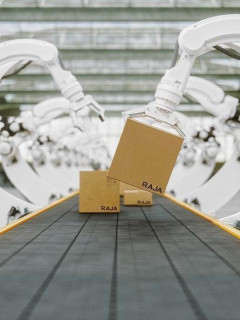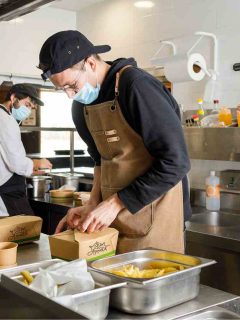In March 2021, IFOP’s “Committed Brands” barometer revealed that 84% of French people want French companies to commit to the environment. This is supported by legislation on food packaging, which is putting increasing pressure on logistics managers.What if you were to use eco-friendly food packaging as an opportunity to improve your brand image and customer experience? This was the challenge taken up by our RAJA experts, Henri Serre (Key Account Sales Director) and Aurélie Blu (Product Manager Buyer), during our latest webinar. Find out more in this article, and make the right choices in terms of food packaging, in line with current and future legislation!
4 regulatory directives on eco-friendly food packaging
The SUP (Single Use Plastics) Directive
Voted on 21 May 2019, and applicable since 3 July 2021, the European SUP directive sets several objectives. On the one hand, it sets the collection of plastic bottles at 90% by 2029; on the other hand, it aims for plastic bottles to contain at least 25% recycled plastic by 2025, and at least 30% by 2023. In addition, it stipulates that caps must be attached to plastic bottles from 2024 onwards. This directive therefore states that..
- Single-use plastic products such as cutlery, plates, straws and stirring sticks are prohibited
- Labelling of products containing plastic (e.g. cups and wipes) is mandatory
note that this regulation provides for a one-year tolerance period to allow distributors to sell off their current stocks of products
The AGEC law (Anti-waste law for a Circular Economy)
passed on 30 January 2020, the AGEC law modifies the famous EGAlim law and transposes the SUP directive into France. The main idea behind this legislation is to announce the end of single-use plastic by 2040, by better informing consumers and encouraging them to reuse packaging (especially food packaging). It promotes, in particular, wider distribution of the TriMan sign, with which you are probably already familiar
the 3R decree (Reduction, Reuse and Recycling)
This 3R decree sets very concrete eco-responsible objectives for the period 2021 – 2025
- Reduce single-use plastic packaging by 20% by the end of 2025
- Aim for 100% recycled single-use plastic packaging, by encouraging the integration of recycled material into it
- Aim for 100% reduction of ‘unnecessary’ single-use plastic packaging by end 2025
 |
 |
 |
 |
 |
 |
 |
 |
Le projet de loi Climat et Résilience
Encore en cours d’examen par le Sénat, ce projet est la traduction d’une partie des propositions des citoyens de la Convention Citoyenne pour le Climat.
Il s’agit de suivre ce projet de près, car il pourra potentiellement apporter des changements aux législations actuelles, relatives à l’utilisation de certains emballages, matériaux, ou dispositifs (comme le vrac ou la consigne).
| Attention !
Suite à la mise en place de ces directives réglementaires, les systèmes de bonus et de malus,
|
émetteurs
d’
- emballages
- alimentaires
- non-écologiques
, se
durcissent
.
Des
- bonus apparaissent
- pour les entreprises
- menant une
- sensibilisation
- aux
gestesde
|
,
ainsi qu
’à
celles
| incorporant dans leurs |
| produits |
| des |
| matières |
















